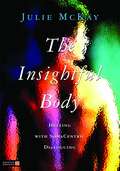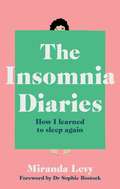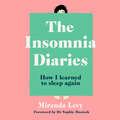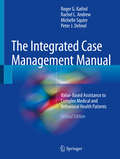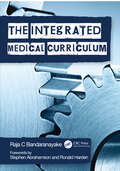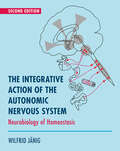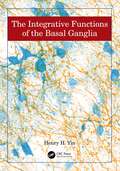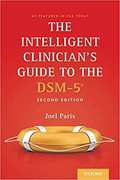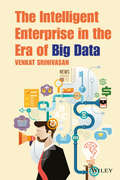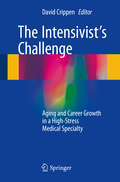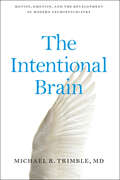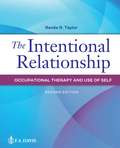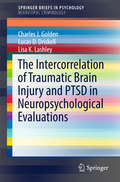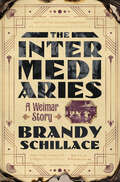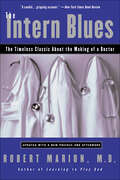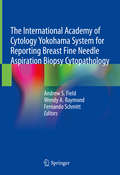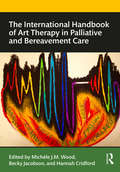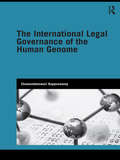- Table View
- List View
The Insightful Body: Healing with SomaCentric Dialoguing
by Julie MckaySomaCentric Dialoguing offers therapists simple yet effective techniques for improving communication with their clients, and for helping clients understand and articulate the messages of their body. In this accessible introduction to the approach, Julie McKay outlines the core techniques and describes how they can be applied to make therapeutic sessions more effective. Explaining that individuals communicate and process information in different ways she describes how therapists can identify each client's unique language blend, and how they can use this knowledge to encourage them to become more in tune with, and more able to express, their body's needs. Guidance is provided on how to ask more effective questions in sessions, what words to use, and what words to avoid, for optimal results. Using carefully chosen words and phrases therapists can empower clients to express themselves freely. Using the simple, yet profound, techniques outlined in this book therapist of all kinds will learn how to look beyond the head and into the body to help clients heal more completely and more deeply. This wonderful resource will provide bodyworkers, acupuncturists, occupational therapists, psychotherapists, movement instructors and a wide range of other healing arts practitioners with the skills they need to refine their dialoguing vocabulary and deliver rich and rewarding sessions.
The Insomnia Diaries: How I learned to sleep again
by Miranda LevyA Financial Times readers' best 2021 summer book'A powerful new book' - The Daily Mail'Quite the story... fascinating' - Claire Byrne, RTE1'This memoir meets manual with expert tips is both honest and helpful' - Victoria Woodhall, Get the GlossFOREWORD BY DR SOPHIE BOSTOCK'29th June 0 HOURS, 0 MINUTES Eleven forty-seven pm. A door slams as the neighbour's teenage son comes home from the pub. An hour later, the last Tube rumbles past and I thump my pillow over to find a cool spot. I refuse to open the window because of my fear of hearing the first bird of morning, confirmation that the next day is about to start and I have failed, yet again. Failed in my quest to sleep, which one would think is a basic human right.But I am not a POW whose captors breach the Geneva Convention. No one has stolen my sleep from me. I am not wired up to electrodes, a neon light is not shining in my face all night long. I have blackout blinds and a king-size bed all to myself. My enemies are my brain and a body that has forgotten how to shut down.'After a single, catastrophic event, journalist Miranda Levy had one sleepless night, then another, and then another. She sought help from anyone she could: doctors, a therapist, an acupuncturist, a hypnotist, a reiki practitioner and a personal trainer - but nothing seemed to work.Sleep, wellbeing and mental health are intrinsically linked. Yet sleeplessness is surprisingly common: 16 million of us suffer from insomnia, and the sleep industry is worth £100 billion (Daily Mail). In The Insomnia Diaries, Miranda Levy tells the story of her experience of severe, disabling insomnia that affected every aspect of her life for years, and how she ultimately recovered. Part memoir, part reportage, this book will help anyone who struggles to get a good night's sleep - whether occasionally or all of the time - appreciate the issues and understand the options as they find their best way to get the rest they need. Dr Sophie Bostock, scientist, sleep expert and member of the team who developed the award-winning digital programme Sleepio, contributes a foreword. She and a host of expert contributors have advised on the medical elements within the text throughout.
The Insomnia Diaries: How I learned to sleep again
by Miranda LevyAfter a single, catastrophic event, journalist Miranda Levy had one sleepless night, then another, and then another. She sought help from anyone she could: doctors, acupuncturists, reiki practitioners, hypnotists, therapists, personal trainers - but nothing seemed to work.Sleep, wellbeing and mental health are intrinsically linked. Yet sleeplessness is surprisingly common: 16 million of us suffer from insomnia, and the sleep industry is worth £100 billion (Daily Mail).In The Insomnia Diaries, Miranda Levy tells the story of her experience of severe, crippling insomnia that affected every aspect of her life for years, and how she ultimately recovered. Part memoir, part reportage, this book will help anyone who struggles to get a good night's sleep - whether occasionally or all of the time - appreciate the issues and understand the options as they find their best way to get the rest they need. Dr Sophie Bostock, scientist, sleep expert and member of the team who developed the award-winning digital programme Sleepio, contributes a foreword. She and a host of expert contributors have advised on the medical elements within the text throughout.(p) 2020 Octopus Publishing Group
The Institutions of Programmatic Action: Policy Programs in French and German Health Policy (International Series on Public Policy)
by Johanna HornungThis open access book is the first monograph to systematically apply the Programmatic Action Framework (PAF) in a comparative analysis of public policy in two institutionally different countries. The PAF seeks to explain long-term policy change by examining the shared biographies of policy actors who, to foster their careers, coalesce around policy programs which they promote throughout the policy process. Comparing health policy-making in France and Germany between 1990 and 2020, the book sheds light on the institutional settings that are necessary for programmatic action to occur. It will appeal to scholars and students of public policy, public administration, and health policy.
The Integrated Case Management Manual: Value-Based Assistance to Complex Medical and Behavioral Health Patients (Springer Ser.)
by Roger G. Kathol Peter J. Dehnel Rachel L. Andrew Michelle SquireThoroughly revised and updated since its initial publication in 2010, the second edition of this gold standard guide for case managers again helps readers enhance their ability to work with complex, multimorbid patients, to apply and document evidence-based assessments, and to advocate for improved quality and safe care for all patients. Much has happened since Integrated Case Management (ICM), now Value-Based Integrated Case Management (VB-ICM), was first introduced in the U.S. in 2010. The Integrated Case Management Manual: Valued-Based Assistance to Complex Medical and Behavioral Health Patients, 2nd Edition emphasizes the field has now moved from “complexity assessments” to “outcome achievement” for individuals/patients with health complexity. It also stresses that the next steps in VB-ICM must be to implement a standardized process, which documents, analyzes, and reports the impact of VB-ICM services in removing patient barriers to health improvement, enhancing quality and care coordination, and lowering the financial impact to patients, providers, and employer groups. Written by two expert case managers who have used VB-ICM in their large fully disseminated VB-ICM program and understand its practical deployment and use, the second edition also includes two authors with backgrounds as physician support personnel to case managers working with complex individuals. This edition builds on the consolidation of biopsychosocial and health system case management activities that were emphasized in the first edition. A must-have resource for anyone in the field, The Integrated Case Management Manual: Value-Based Assistance to Complex Medical and Behavioral Health Patients, 2nd Edition is an essential reference for not only case managers but all clinicians and allied personnel concerned with providing state-of-the-art, value-based integrated case management.
The Integrated Medical Curriculum
by Raja C. BandaranayakeIt is increasingly recognised that the medical education curriculum should re-integrate basic sciences and clinical disciplines. This would enhance students' ability to integrate previous and future learning, link theory and professional standards to practice, and adapt to change.
The Integrated Medical Library (Routledge Revivals)
by Ms. Helis MiidoFirst published in 1991, Library automation has advanced at such a rapid pace within the last few years that librarians who have been limited by either budget or hardware constraints are today able to automate at least some library functions. Even though presentations at meetings describing individual efforts have been published in the literature, there has not been a comprehensive text discussing the status of integration at all levels of library management as it exists today. The Integrated Medical Library addresses this need by presenting the results of a survey of automated systems currently used in medical libraries as a basis on which to discuss various methods for integrating these systems. This includes serials, cataloging, circulation, acquisitions, internal database management systems, external database search procedures, and management and financial control. The book emphasizes current practices and procedures and proposes methods for libraries to improve their performance and services.Part I defines an integrated online library system and describes the study design and analysis of results. Part II describes commercially available integrated online library systems currently used by medical libraries. Part III discusses the specialized integrated online library systems of the U.S. National Library of Medicine and the Swedish Planning and Rationalization Institute for the Health and Social Services. Part IV describes ad hoc integrated functions currently used by medical libraries, while Part V discusses the various means of integration.
The Integrated Nervous System: A Systematic Diagnostic Case-Based Approach, Second Edition
by Walter J. Hendelman Christopher R. Skinner Peter HumphreysThis innovative textbook is modelled on problem-based learning. It bridges the gap between academic neuroanatomy and clinical neurology and effectively takes the reader from the classroom to the clinic, so that learning can be applied in practice. This second edition has been updated and expanded to include many more clinical cases within both the book and the accompanying Wweb site. Significant additions include abbreviated presentation of the history and neurologic examination of all the cases on the web site (now numbering over 50) within the text at the end of each of the clinical chapters. new ‘maps’ -- visual representations of the clinical motor, sensory and reflex findings. the web site further expands the cases – presenting them in detail, and providing an ‘expert’ commentary to discuss the reasoning for the localization and etiological diagnosis. This book and the associated Web site will be of practical value to all the professionals who deal with people who have neurological conditions, as well as being invaluable to medical students and residents. This includes physiatrists (rehabilitation medicine specialists), physiotherapists, occupational therapists and speech therapists, and nurses who specialize in the care of neurological patients. We think that this text will also be of value for family physicians and specialists in internal medicine and pediatrics, all of whom must differentiate between organic pathology of the nervous system and other conditions.
The Integration of the Humanities and Arts with Sciences, Engineering, and Medicine in Higher Education: Branches From The Same Tree
by Engineering Medicine National Academies of SciencesIn the United States, broad study in an array of different disciplines —arts, humanities, science, mathematics, engineering— as well as an in-depth study within a special area of interest, have been defining characteristics of a higher education. But over time, in-depth study in a major discipline has come to dominate the curricula at many institutions. This evolution of the curriculum has been driven, in part, by increasing specialization in the academic disciplines. There is little doubt that disciplinary specialization has helped produce many of the achievement of the past century. Researchers in all academic disciplines have been able to delve more deeply into their areas of expertise, grappling with ever more specialized and fundamental problems. Yet today, many leaders, scholars, parents, and students are asking whether higher education has moved too far from its integrative tradition towards an approach heavily rooted in disciplinary “silos”. These “silos” represent what many see as an artificial separation of academic disciplines. This study reflects a growing concern that the approach to higher education that favors disciplinary specialization is poorly calibrated to the challenges and opportunities of our time. The Integration of the Humanities and Arts with Sciences, Engineering, and Medicine in Higher Education examines the evidence behind the assertion that educational programs that mutually integrate learning experiences in the humanities and arts with science, technology, engineering, mathematics, and medicine (STEMM) lead to improved educational and career outcomes for undergraduate and graduate students. It explores evidence regarding the value of integrating more STEMM curricula and labs into the academic programs of students majoring in the humanities and arts and evidence regarding the value of integrating curricula and experiences in the arts and humanities into college and university STEMM education programs.
The Integrative Action of the Autonomic Nervous System: Neurobiology of Homeostasis
by Wilfrid JänigAlmost all bodily functions are dependent on activity of the autonomic nervous system – from the cardiovascular system, the gastrointestinal tract, the evacuative and sexual organs, to the regulation of temperature, metabolism and tissue defence. Balanced functioning of each aspect of this system is an important basis of our life and well-being. In this long-awaited second edition, the author, a leading figure in this field, provides an up-to-date and detailed description of the cellular and integrative organization of the autonomic nervous system, covering both peripheral and central aspects. The book exposes modern neurobiological concepts that allow us to understand why this system normally runs so smoothly and why its deterioration has such disastrous consequences. This broad overview will appeal to researchers and advanced undergraduate students of the various biological and medical sciences studying how the autonomic nervous system works and to clinicians and physical therapists whose practice involves systems dependent on autonomic functions.
The Integrative Functions of The Basal Ganglia
by Henry YinThis volume is the first comprehensive and single-authored book on the functions of the basal ganglia. The goal is to provide a new synthesis of diverse areas of research on the basal ganglia, from cellular mechanisms of synaptic transmission and plasticity to neural circuit mechanisms underlying behavior. A global theory of basal ganglia function incorporating research from the last 40 years is presented. I hope to explain for the first time how the basal ganglia generate behavior, how they contribute to learning and memory, and how impairments in basal ganglia function can lead to neurological and psychiatric disorders. Features The only single-authored book on the basal ganglia with coverage of the latest literature. Spans multiple levels of analysis, from cellular physiology to behavior. Includes coverage of clinical symptoms, encompassing neuropsychology, movement disorders, and psychiatric disorders. Discusses the role of the basal ganglia in learning and memory.
The Intelligent Clinician's Guide to the DSM-5
by Joel ParisThe Intelligent Clinician's Guide to the DSM-5 is the second edition of the widely-read book first published in 2013. This second edition is thoroughly revised, and has several new chapters describing the response to the publication of the new manual, as well as suggestions on its use in clinical practice. <P><P> The Intelligent Clinician's Guide to the DSM-5, Second Edition reviews the history of diagnosis in psychiatry, emphasizing the limitations for classification of our current lack of knowledge of the causes of most mental disorders. It emphasizes that, in the absence of biomarkers, current categories can only be considered provisional. It takes a critical look at schema for spectra and dimensionalisation of diagnosis, examines the borders between normality and psychopathology, and discusses the problem of clinical utility. The book has chapters on all the major diagnoses in psychiatry, in which the main problems of diagnosis are addressed, and in which all changes in DSM-5 are described.
The Intelligent Enterprise in the Era of Big Data
by Venkat SrinivasanAn innovative guide to the organization and function of enterprises in the technological age In the era of big data and automation, this book presents a cutting-edge approach in how enterprises should organize and function. Striking a practical balance between theory and practice, The Intelligent Enterprise in the Era of Big Data presents an enterprise architecture that embodies the power of the emerging technology environment. Beginning with an introduction to the key challenges that enterprises face, the book systematically outlines a modern enterprise architecture through a detailed discussion of the inseparable elements of such an architecture: efficiency, flexibility, and intelligence. This architecture enables rapid responses to market needs by facilitating intelligent, flexible automation of enterprise business processes and sensing important developments in internal and external environments in near real time. Illustrating all of these elements in an integrated fashion, The Intelligent Enterprise in the Era of Big Data also features: A detailed discussion on issues of time-to-market and flexibility with respect to enterprise application technology Novel analyses illustrated through extensive real-world case studies to help readers better understand the applicability of the architecture and concepts Practical approaches for designing and building intelligent enterprises An appendix that presents various approaches to text analysis with real-world business implications The Intelligent Enterprise in the Era of Big Data is an appropriate reference for business executives, information technology professionals, data scientists, and management consultants.
The Intensivist's Challenge
by David CrippenThis book brings together personal narratives from critical care medicine specialists around the world. Most of these physicians started in critical care at or before the exponential increase in technological modalities to reverse or sustain organ function, have seen patient care both ways, and have worked as many as 30 years or more at the bedside. The narratives are organized around such themes as : how and why these physicians entered the discipline of critical care; what was critical care like in the beginning; how they have experienced the flood of innovations in critical care; why they decided to retire (or not); and what their retirement options have been (or not). Composed by influential critical care medicine specialists, The Intensivist's Challenge: Aging and Career Growth in a High-Stress Medical Specialty is a valuable resource bringing together a discussion of the nature and problems of aging as they apply to physicians in a high-stress occupation, while assessing the value of clinical experience at the bedside in a world increasingly full of soulless technology.
The Intentional Brain: Motion, Emotion, And The Development Of Modern Neuropsychiatry
by Michael R. Trimble“A tour de force: an assessment of the ‘culture’ of mind–brain relations beginning with the ancients and ending in the present.” —Edward Shorter, PhD, National Book Award finalist and author of A History of PsychiatryNeuropsychiatry has a distinguished history, yet its ideals and principles fell out of fashion in the early twentieth century as neurology and psychiatry diverged into separate disciplines. Later, neuropsychiatry reemerged as the two disciplines moved closer again, accelerated by advances in neuroanatomy, neurochemistry, and drugs that alter the functioning of the central nervous system. But as neuropsychiatrist Michael R. Trimble explains in The Intentional Brain, the new neuropsychiatry has its own identity and is more than simply a borderland between two disparate clinical disciplines.Looking at neuropsychiatry in the context of major cultural and artistic achievements, Trimble explores changing views of the human brain and its relation to behavior and cognition over 2,500 years of Western civilization. Beginning with the early Greek physicians and moving through the Middle Ages, Enlightenment, Romantic era, World Wars, and present day, he explores understandings about the brain’s integral role in determining movement, motivation, and mood. Persuasively arguing that storytelling forms the backbone of human culture and individuality, Trimble describes the dawn and development of artistic creativity and traces the conflicts between differing philosophical views of our world and our position in it.A sweeping history of the branch of medicine concerned with both psychic and organic aspects of mental disorder, the book reveals what scientists have learned about movement and emotion by studying people with such diseases as epilepsy, syphilis, hysteria, psychosis, movement disorders, and melancholia. The Intentional Brain is a marvelous and interdisciplinary look at the clinical interface between the mind and the brain.
The Intentional Brain: Motion, Emotion, and the Development of Modern Neuropsychiatry
by Michael R. TrimbleA magnificent examination of the clinical interface between the mind and the brain.Neuropsychiatry has a distinguished history, yet its ideals and principles fell out of fashion in the early twentieth century as neurology and psychiatry diverged into separate disciplines. Later, neuropsychiatry reemerged as the two disciplines moved closer again, accelerated by advances in neuroanatomy, neurochemistry, and drugs that alter the functioning of the central nervous system. But as neuropsychiatrist Michael R. Trimble explains in The Intentional Brain, the new neuropsychiatry has its own identity and is more than simply a borderland between two disparate clinical disciplines.Looking at neuropsychiatry in the context of major cultural and artistic achievements, Trimble explores changing views of the human brain and its relation to behavior and cognition over 2,500 years of Western civilization. Beginning with the early Greek physicians and moving through the Middle Ages, the Enlightenment, the romantic era, the World Wars, and up to the present day, he explores understandings about the brain’s integral role in determining movement, motivation, and mood. Persuasively arguing that storytelling forms the backbone of human culture and individuality, Trimble describes the dawn and development of artistic creativity and traces the conflicts between differing philosophical views of our world and our position in it.A sweeping history of the branch of medicine concerned with both psychic and organic aspects of mental disorder, the book reveals what scientists have learned about movement and emotion by studying people with such diseases as epilepsy, syphilis, hysteria, psychosis, movement disorders, and melancholia. The Intentional Brain is a marvelous and interdisciplinary look at the clinical interface between the mind and the brain.
The Intentional Relationship: Occupational Therapy And Use Of Self
by Renee R. TaylorThis groundbreaking book addresses a critical aspect of the occupational therapy practice—the art and science of building effective therapeutic relationships with clients. A distinguished clinician, scientist, and educator, Renée Taylor, PhD, has defined a conceptual practice model, the Intentional Relationship Model, to identify how the client and the therapist each contribute to the unique interpersonal dynamic that becomes the therapeutic relationship. She emphasizes how therapists must act deliberately, thoughtfully, and with vigilant anticipation of the challenges and breakthroughs that have the potential to influence the course of the relationship.
The Intercorrelation of Traumatic Brain Injury and PTSD in Neuropsychological Evaluations
by Charles J. Golden Lucas D. Driskell Lisa K. LashleyThis concise reference clarifies the gray areas between traumatic brain injury and PTSD while providing an empirically sound framework for neuropsychological evaluation and differential diagnosis. Its extended research review summarizes findings on key topics including the neuroanatomy of brain injury, test battery design and selection, and the salience of accurate diagnosis to ensuring appropriate specialized treatment. The authors offer the possibility of combined diagnosis as well as injuries that may fall through the diagnostic cracks, and consider possible relationships between TBI, PTSD, and the dementias, including Alzheimer's disease. This knowledge base and the practical guidelines it informs are presented so that readers can better: #65533; Understand the clinical distinctions between TBI and PTSD, and among forms of TBI. #65533; Recognize cognitive, behavioral, emotional, and social components of the disorders. #65533; Identify skill areas for neuropsychological evaluation of patients. #65533; Select appropriate instruments for individualized assessment. #65533; Address test administration and interpretation concerns. #65533; Make an accurate differential diagnosis between PTSD and TBI. With its sharp focus on the nuances of trauma and recovery, The Intercorrelation of Traumatic Brain Injury and PTSD in Neuropsychological Evaluations will find a wide, interested audience among psychologists, neuropsychologists, neurologists, psychiatrists, social workers, mental health counselors, undergraduate and graduate level students, and researchers. In addition, this text may be useful for those interested in psychology and neurology.
The Intermediaries: A Weimar Story
by Brandy SchillaceThe fascinating history of a daring team of sexologists who built the first trans clinic in the shadow of the Third Reich. Set in interwar Germany, The Intermediaries tells the forgotten story of the Institute for Sexual Science, the world’s first center for homosexual and transgender rights. Headed by a gay Jewish man, Dr. Magnus Hirschfeld, the institute aided in the first gender-affirming surgeries and hormone treatments, acting as a rebellious base of operations in the face of rising prejudice, nationalism, and Nazi propaganda. An expert in medical history, Brandy Schillace tells the story of the Institute through the eyes of Dora Richter, an Institute patient whom we follow in her quest to transition and live as a woman. While the colorful but ultimately tragic arc of Weimar Berlin is well documented, The Intermediaries is the first book to assert the inseparable, interdependent relationship of sex science to both the queer rights movement and the permissive Weimar culture, tracking how political factions perverted that same science to suit their own ends. This riveting book brings together forgotten scientific and surgical discoveries (including previously untranslated archival material from Berlin) with the politics and social history that galvanized the first stirrings of the trans rights movement. Through its unforgettable characters and immersive, urgent storytelling, The Intermediaries charts the relationships between nascent sexual science, queer civil rights, and the fight against fascism. It tells riveting stories of LGBTQ pioneers—a surprising, long-suppressed history—and offers a cautionary tale in the face of today’s oppressive anti-trans legislation.
The Intern Blues: The Timeless Classic About the Making of a Doctor
by Robert MarionThe classic “gripping account” of three young doctors in training at a New York City hospital, updated with a new preface and afterword (The New York Times Book Review).While supervising a small group of interns at a major New York medical center, Dr. Robert Marion asked three of them to keep a careful diary over the course of a year. Andy, Mark, and Amy vividly describe their real-life lessons in treating very sick children; confronting child abuse and the awful human impact of the AIDS epidemic; skirting the indifference of the hospital bureaucracy; and overcoming their own fears, insecurities, and constant fatigue. Their stories are harrowing and often funny; their personal triumph is unforgettable.This updated edition of The Intern Blues includes a new preface from the author discussing the status of medical training in America today and a new afterword updating the reader on the lives of the three young interns who first shared their stories with readers more than a decade ago.“Thought-provoking, informative.” —Publishers Weekly‘The diary format effectively dramatizes the often-agonizing decisions and compromises that are made in the face of sleepless nights and inexperience . . . an important book for anyone contemplating the long, arduous task of becoming a doctor.” —Library Journal
The International Academy of Cytology Yokohama System for Reporting Breast Fine Needle Aspiration Biopsy Cytopathology: Special Topic Issue: Acta Cytologica 2019, Vol. 63, No. 4
by Fernando Schmitt Andrew S. Field Wendy A. RaymondThis text describes a system of reporting breast fine needle aspiration biopsy that uses five clearly defined categories, each described by a specific term and each with a specific risk of malignancy. The five categories are insufficient/inadequate, benign, atypical, suspicious of malignancy and malignant. Each category has a risk of malignancy and is linked to management recommendations, which include several options because it is recognized that diagnostic infrastructure, such as the availability of core needle biopsy and ultrasound guidance, vary between developed and low and middle income countries. This text includes key diagnostic cytological criteria for each of the many lesions and tumors found in the breast. The cytopathology of specific lesions is illustrated with high quality photomicrographs with clear figure descriptions. Chapters also discuss current and potential future ancillary tests, liquid based cytology, nipple cytology and management. An additional chapter provides an overview of an approach to the diagnosis of direct smears of breast fine needle aspiration biopsies.The International Academy of Cytology Yokohama System for Reporting Breast Fine Needle Aspiration Biopsy Cytopathology provides a clear logical approach to the diagnosis and categorization of breast lesions by FNAB cytology, and aims to facilitate communication with breast clinicians, further research into breast cytopathology and related molecular pathology, and improve patient care.
The International Handbook of Art Therapy in Palliative and Bereavement Care (Routledge International Handbooks)
by Hannah Cridford Michèle J.M. Wood Becky JacobsonThe International Handbook of Art Therapy in Palliative and Bereavement Care offers a multicultural and international perspective on how art therapy can be of help to individuals, groups, families, communities, and nations facing death and dying as well as grief and loss. Over 50 art therapists from around the world write about the transforming power of art therapy in the lives of those facing terminal illness, dementia, loss, and grief. They offer practical descriptions and techniques for working with adults and children to guide professionals, including those new to using art therapy and creative approaches in end-of-life care services. This international handbook is essential reading for arts therapists, social workers, medical personnel, faith leaders, and psychologists interested in a collaborative and accessible approach to working with patients and families affected by loss.
The International Legal Governance of the Human Genome (Genetics and Society)
by Chamundeeswari KuppuswamyThe human genome is a well known symbol of scientific and technological progress in the twenty-first century. However, concerns about the exacerbation of inequalities between the rich and the poor, the developing and the developed states, the healthy and the unhealthy are causing problems for the progress of scientific research. The international community is moving towards a human rights approach in addressing these concerns. Such an approach will be piecemeal and ineffective so long as fundamental issues about economic, social and cultural rights, the so-called second generation of human rights, are not addressed. This book argues that, in order to be able to meaningfully apply a human rights framework to the governance of the human genome, the international human rights framework should be based on a unified theory of human rights where the distinction between positive and negative rights is set aside. The book constructs a common heritage concept with the right to development at its core and explores the content of the right to development through rational human rights theory. It is argued that the notion of property rights in the human genome should be placed within the context of protecting human rights, including the right to development. The concept of common heritage of humanity, contrary to the widely held belief that it is in opposition to patenting of gene sequences, supports human rights-based conceptions of property rights. This book fills a gap in the literature on international legal governance of the human genome will provide an essential reference point for research into the right to development, development issues in bioethics, the role of international institutions in law making and research governance.
The International Migration of Health Workers
by Rebecca S. ShahExperts from ethicists and political philosophers to clinicians and trade unionists seek answers to a number of key ethical questions to further a deeper understanding of the ethics of health worker migration.
The International System for Serous Fluid Cytopathology
by Fernando Schmitt Ashish Chandra Barbara Crothers Daniel KurtyczThis book is the culmination of an international effort to bring consistency and diagnostic efficiency to effusion cytology for the sake of patient care. The authors recognize special challenges in serous fluid cytopathology, such as reporting the presence of Mullerian epithelium in peritoneal fluids. What is an appropriate serous fluid volume to ensure adequacy? How should mesothelial proliferations be reported and is it appropriate to make an interpretation of malignant mesothelioma? How specific should a report be regarding the origin and subtyping of tumors found in serous fluids? What are the appropriate quality monitors for this specimen type? Special chapters on considerations for peritoneal washings, cytopreparatory techniques, mesothelioma and quality management are included to address these issues. The text contains literature reviews that elucidate existing evidence in support of current practices and recommendations. Expert opinions on where evidence was lacking, the most common practices were adopted by consensus, and where there was no commonality, are employed. Written by experts in the field, The International System for Serous Fluid Cytopathology serves as a collaborative effort between the International Academy of Cytology and the American Society for Cytopathology and calls upon participation of the international cytopathology and oncology communities to contribute to the development of a truly international system for reporting serous fluid cytology
